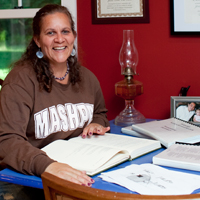
Language can come home again. This is the tremendous lesson that I witnessed in the remarkable documentary, “We Still Live Here – Âs Nutayuneânby,” by Director/Producer Anne Makepeace. The true story of how the Wampanoag language came home recently earned the Full Frame Inspiration Award at the Full Frame Documentary Festival, and it was so very well deserved. Makepeace hands us a gift of an educational tool also; this film drops lesson after lesson about how culture, language, history and community are deeply intertwined. Here is the trailer (which, in my humble opinion, doesn’t even begin to do the film justice:)
Makepeace documents the story of Jessie Little Doe Baird, a Wampanoag Indian whose dream of her ancestors sparked her to explore her tribe’s native language. The challenge was that no one actually spoke Wampanoag; there was simply no one left to ask. The language had been dead for a century, yet Jessie’s visions of her ancestors trying to tell her something (arriving in her dream with a large book and speaking in a language that she didn’t understand) moved her to seek out what was left of her ancestral language.
The Wampanoag Indians were the first to greet the Pilgrims in 1620 in what is now Massachusetts. At the time Jessie had her dream about her ancestors, the Wampanoag remaining only spoke English. A determined Jessie sought out documents that had been written in Wampanoag, trying to piece together the language as best she could. Her quest led her to MIT, where she worked with some of the world’s finest linguists, despite never having attended college. (She ultimately went on to earn a master’s degree in Linguistics from MIT – what an inspiration!) Through researching documents, including the Bible – which had been translated into Wampanoag, Jessie began to develop the first Wampanoag dictionary. When words didn’t exist in historical texts, she pulled words from other native languages and used a formula to develop what the original Wampanoag words may have been. She created new words to define modern items such as backpack and computer. Her community rallied around her to support her efforts, illustrating that it truly does ‘take a village.’ We experience Jessie’s leadership and also the strength and passion of the Wampanoag community. Without them, her work would not have been possible.
Jessie’s and her community’s passion for their culture moved them to teach Wampanoag to a new generation. Jessie’s young daughter, Mae, is the first native Wampanoag speaker in SEVEN generations! I literally had chills watching Jessie and Mae speak in Wampanoag and while writing notes during the film, I kept writing MUST BLOG, MUST BLOG. It was the first film that I saw at the festival that moved me to my core and made me feel incredibly empowered! After all, if a busy mother can resurrect a language and a little girl can learn a completely new language, perhaps we can learn one too.
This film is an exciting new educational tool. It illustrates the power of language and how we can learn about a people’s culture and history through it. For example, the Wampanoag word used to describe how they were losing their land literally can be translated to “fall off your feet.” There are a variety of words to describe water in this language: lake water, river water, drinking water, etc. There is plenty of evidence that the Wampanoag people prayed using the Bible simply because they knew it would provide the right to stay on their land, which was vital to their culture.
It is a film that should be shown to students studying languages – any of them – because it shows the power of language and the gift of learning one. I challenge you not to want to pick up a language class after seeing this film.
International students will benefit from this documentary, as it serves as a meaningful history lesson on the realities of what happened to the native peoples when the settlers came to the United States. Clearly, it is a film that can easily be included in anthropology and history curricula.
The Wampanoag Language Reclamation Project offers information about where language lessons are taught, the status of the project and more. The film is for sale through Anne Makepeace’s website. The fee for educational screening rights is incredibly affordable.
Jessie Little Doe Baird was named a MacArthur Fellow in 2010. The Fellowship is a $500,000, no-strings-attached grant for individuals who have shown exceptional creativity in their work and the promise to do more. Here is more information about her work:

Hey Thank you so much! I learned of this group when I was doing my practicum to support a Quaker group wanting to start a peace museum called Envision Peace in Philadelphia. In my research I found John Norwood who introduced me to the story he wrote called "We Are Still Here" about the Nanticoke and Lenape Indians.
Thanks for sharing this Hope. I am glad that you enjoyed the post. It is a fascinating project!
What a powerful and important story that guides us to new understandings of the nature, conditions and effects of the history and presence of Europeans in the land of the Wampanoag. If you live "here", you need to see "We Still Live Here".
Eloquently stated Ukumbwa! I couldn’t agree more – it really is a “must see” film!